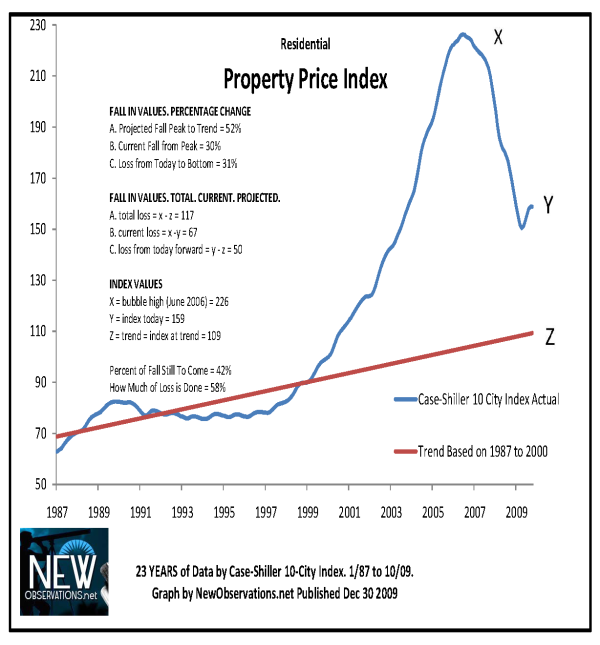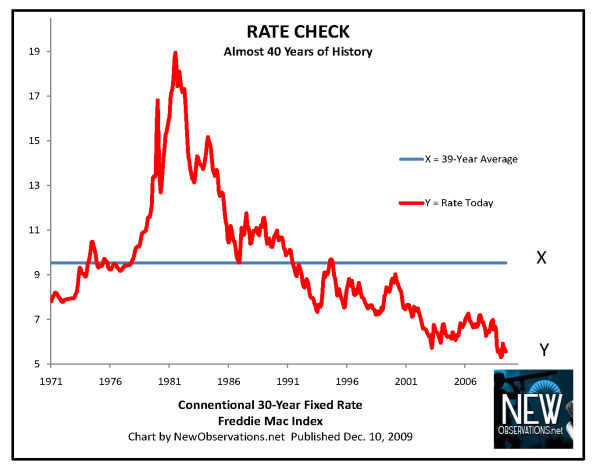Property Values: The Numbers Still Say 30% Down 30% Left To Fall
It’s very nice that values achieved a gain of .013% in October, but we still have a 30% fall ahead of us and, as you know, we have a 30% fall behind us. Better send in your mortgage payment.
The S&P/Case-Shiller Home Price Index released Tuesday is up 5.6% from April. Besides the movement up since April, the severity of the annual decline has steadily decreased in the last nine months.
October prices of real estate were down 6.4% from the previous year. January prices this year were down more than 19% from the year-earlier period.
“All in all, this report should be described as flat.” says David M. Blitzer, Chairman of the Index Committee at Standard & Poor’s, the publisher of the index.
Average home prices are now equal to prices in Fall 2003. The headline estimate of a 30% fall still to come is based upon a trend line derived from data between 1987 and 2000. The presumption is that the values after 2000 are bubble values and that they should be excluded.
If you think this can’t happen, consider Las Vegas. They have naked dancing girls and values which are still up from January 2000. The gain is all of 5% from that time. Now that 5% up isn’t as good as it used to be over there. At one time our desert community swam in real estate appreciation of 135% from January 2000. Most professionals refer to the Vegas real-estate investment environment as whiplashy.
Some reality does break through the clouds of the economics profession. “Foreclosure and delinquency rates, which hit a record high at the end of the third quarter, are likely to continue to rise, perhaps sharply,” said Patrick Newport, US economist at HIS Global Insight, quoted in TimesOnline. “In addition to this, the inventory of homes for sale remains near record highs.”
Others think the bottom is done and we are moving up from here. “We would not be surprised to see some weakening in prices through the winter months, when demand is generally low and as distressed properties continue to get dumped onto the market,” wrote Michelle Girard, economist at RBS PLC, and quoted in the Wall Street Journal. “However, with every passing month it looks like the bottom in home prices has been put in.”
We are in a Goliath versus Goliath match. The multi-prong attack against falling prices by the United States government includes radical intervention via Fannie Mae, Freddie Mac, FHA, the home-buyer tax credit, the purchase of mortgage-backed securities, the purchase of treasury bonds, and the provision of an equity credit line at Fannie and Freddie — the mortgage monsters who will lose more money than any institution in the aftermath of the financial crisis.
Well, somebody might lose more in some version of an infinite loss in the derivatives market. Maybe Fannie and Freddie can come out ahead – of somebody? We may have even hit a bottom in real estate prices.
With interest rates at zero percent, the people who can borrow borrow for free. If major banks can borrow and it costs nothing, that’s a darn nice way to try to make money by borrowing and buying. Does anybody remember the word “leverage”? Our government policies have replicated the method of creating a credit bubble.
If real estate values don’t return to a norm, which predicts a huge fall, it means that a new breakable bubble is gathering strength. Fraud begets fraud. Only failure will end the fraud. Given the heroic effort required to quiet the current-crisis fear, the failure we are building up cannot be measured. It’s too big to count. Numbers don’t go that high.








I see home prices dropping by only another 15% according to my calculations i posted on spiritnewsdaily.com Economy page. Using historical data going back to the 1930’s
Michael,
Nice article..except the basis for the trend. Sorry…don’t get it. There were two housing bubbles during the time you chose to use as “normal”…1989 and by 2000 there was a second bubble. In such a cyclical market you need a hypothesis to work off rather than just time series “eye balling” – try taking out inflation then trending gdp, earnings and leaving in the time series eyeball. Having done this for the UK I think you will find that illuminating, as well as giving a very clear view of what cheap looks like.
Liam
Your assessment seems fairly honest. I find that refreshing. So used to sales numbers and figures that I can’t tell you how much just a plain statement of facts. Makes it worth reading this. I will bookmark you.